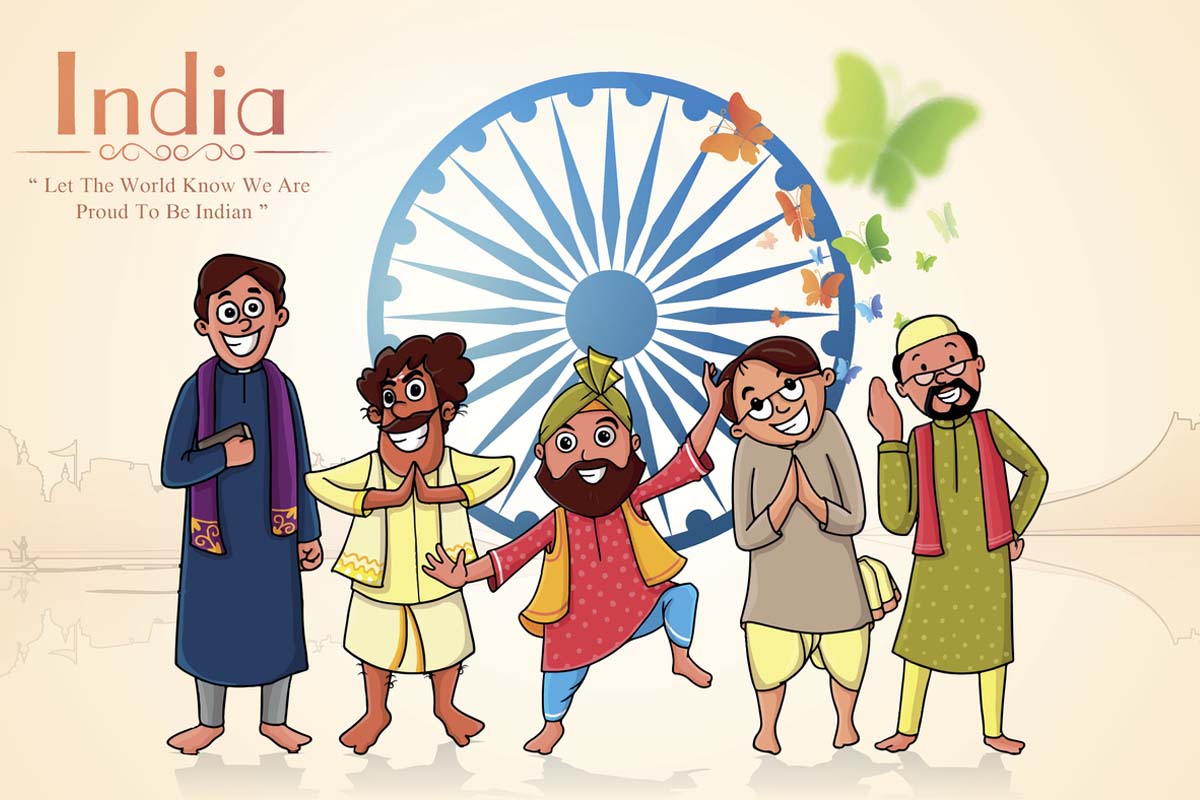“Iyearn for the heart of friendship between the Hindus, Sikhs and Muslims. It subsisted between them the other day. Today it is non-existent. It is a state that no Indian patriot worthy of the name can contemplate with equanimity,” said Gandhiji on the eve of the last fast to bring about true unity among Indians, on 12 January 1948. It is our misfortune that the Mahatma’s words still ring true. One can still remember how in the midst of the communal frenzy the members of the Constituent Assembly were busy framing the Constitution of India.
Nehru also dreamed of a secular India. He said that the Constituent Assembly had “put aside many of the dangerous features of our old Constitution which led to communalism. Whether any other remaining features will remain or not I cannot obviously guarantee, but so far as I am concerned I hope that the less we have any form of communalism the better our Constitution and the practical working of our government.”
There were good reasons why the then Prime Minister could not be sure of what kind of Constitution would emerge. The battle for a truly secular India was being fought in Parliament. All attempts at incorporating the true ideals of secularism failed because of powerful vested interests. And there was the voice of backwardness and obscurantism which wanted to ensure that when the state did anything with reference to the secular aspects of religion it should not touch personal law, and thus the old British colonial policy got incorporated into Independent India’s Constitution.
In the name of religion, civil liberties and democratic rights were suppressed. No religion did recognise equality between the sexes. And personal law deprived women of their basic rights and give them equality guaranteed under Article 14. Meanwhile communalism grew and in the midst of the noise of shooting and killing, rioting and looting the voice of secular India became silent. In 1976, the word ‘’secularism” was mysteriously inserted into the Preamble; it was nowhere defined.
However, in our country secularism has been equated with communal harmony based on a tolerance of all religions. This perspective is reflected in speeches and songs directed at spreading communal harmony. Old Raj Kapoor films are the best reflection of this tradition, specially his famous song “Hindu, Muslim, Sikh, Isai, sabko mera salaam”. We may take pride in this tradition of religious tolerance, but this image is based on an attitude of selfrighteousness which finds no correspondence with reality.
The problem is, in fact, much deeper. Even if we were to achieve a state of religious tolerance, we would still not be a secular state. For secularisation of a society and a culture is a universal process. It is a process by which more and more areas of culture, polity, economy and society become divorced from religion, till the time when religion becomes a purely private affair between each individual and his god. Religion in India is a major force for repression of democratic movements. It is synonymous with inequality, irrationality and superstition. Yet, our Constitution protects religion and religious freedom. And it is significant that it is silent on a more fundamental right– the right to freedom of consciousness.
However, what is of most serious concern is that there is no inbuilt resistance in Indian society to communal forces. Gandhiji started preaching his brand of secularism long ago but riots still take place. There is perhaps no other country in the world where so many people die in social, communal and ethnic strife. It is time we examined our value system to identify inadequacies because of which secularism seems to collapse. One obvious inadequacy of our value system is that we have a distorted perception of secularism. According to the Oxford dictionary, the word “secular” means sceptical of religious truth or opposed to religious education etc.
The word has a strong anti-religious tinge. Secularism grew in the West out of a bitter struggle against religious superstitions. But in India the Gandhian perception of secularism is religious tolerance. This is, however, gradually degenerating into religious intolerance. This is evident from the government banning beef or pork sometimes, somewhere.
The Indian national movement was sought to be made an umbrella for three separate streams – the Hindu masses who were aroused by Gandhiji through the free use of Hindu idioms and symbols, the Muslim stream which was sought to be mobilised through the agency of the ulemas, mainly of Khilafat movement and the Sikh stream through the Gurdwara movement. The first defeat of this approach was when a section of the Muslim masses went out of the fold of the independence movement and Pakistan was created.
The conceptual inadequacy of the national movement is manifested in the frequent riots taking place in the country. The Indian state had made a commitment to secularism which happens to be a Western concept. The Western concept of secular makes sense in contrast to the idea of a theocratic or mono-religious state, but it yields very little positive content for shaping national goals and options for India today.
The Western concept of secular is best exemplified by two of its features – modern science and technology and the urban-industrial civilisation with its special paradigms and institutions of state, education, health and development. It would be appropriate to question these two features in focusing on the distinction between the western secular and the Indian secular. Let us be first clear that the dual assumptions are common to both basic types of western political economy – the Marxist- Leninist and Liberal-Democratic.
For some decades, sensitive people in the West have been holding that the Liberal-Democratic ideology is empty and without real content, except for undefined and unclear concepts of liberty, equality and fraternity thrown up by the bourgeois French revolution more than two centuries ago. But today Marxist- Leninism is confessing to its own bankruptcy and beginning to adopt many of the features of the hitherto despised liberal democracy and its classic product, the market economy.
Western liberal democracy has been trying for a long time to give itself a humanistic base but in terms of rational validity, humanism is confronted by many difficulties in justifying itself. Liberalism has sought to add several new concepts to the trio of liberty, equality and fraternity. Equality is being replaced by the concept of justice and fraternity by the twin notions of dignity of all human beings and the unity of all humanity.
But neither the concept of justice nor the twin concepts of humanity’s unity and personal dignity of each human being can be demonstrated on the secular ground of critical rationality. John Rawls has shown unequivocally that our present operative notion of justice is philosophically based on the prior concept of human right, which in turn was based on untenable Kantian philosophical grounds. Neither can the concept of democracy be defended on purely secular rational-critical grounds.
These are affirmations which have their roots in Western religious tradition and have been smuggled into the secular philosophy without justification by critical rationality. Western secularism is thus built on shaky philosophical foundations. In this, neither Marxism-Leninism nor Western liberalism has any advantage over the other. In India, however, at the time of Independence we were driven more by the need to abjure the concept of a Hindu India in opposition to an Islamic Pakistan, than by a positive commitment to secularism.
The characteristic feature of Western secularism and European enlightenment in the 18th century was the repudiation of the authority of religion and tradition. Dignaga, the Buddhist logician, also repudiated the authority of the Sabda Pramana and built rigorously on the twin principles of pratyaksha (self-perception) and anumaan (inference) without depending on any religious scriptures or traditions.
Western critical rationality also claims to build exclusively on experience and reason without resorting to any tradition. Dignaga arrives at the Buddha – nature or Dharma – as the nature of all reality while Western secularism arrives at a critical rationality based on subject-object dualism, and the desire to dominate by external control. Buddhism in general rejected the authority of scriptures but it did not enthrone critical reason or scientific rationality as the ideal. The first major difference between Buddhist and Western secularism lies in the rejection of ”naive realism” by the former and its acceptance by the latter.
Western secularism takes things to be what they appear to be. Dinnaga insists that things are not what they appear to be. Reality has to be sought beyond the mere appearance through the transcendent experience of samyak sambodhi or “auspicious enlightenment”. The second difference lies in the ocean of difference between enlightenment through critical rationality and enlightenment through an inner illumination that dispels the illusion of the centrality of the ego, and sheds light on the transcendent unity of god, humanity and the world.
This is central to both the Buddhist and the Vedantic tradition, but properly interpreted it can be acknowledged by all traditions. This is not to plead for total rejection of European enlightenment and its categories. In India, a tradition may be evolved that bears out the illumination of critical rationality and the inner enlightenment of seeing the transcendent unity of all in a creative dialectic tradition, which can be both liberating and exhilarating.
(The writer, a former Associate Professor, Department of English, Gurudus College, is associated with Rabindra Bharati University)











